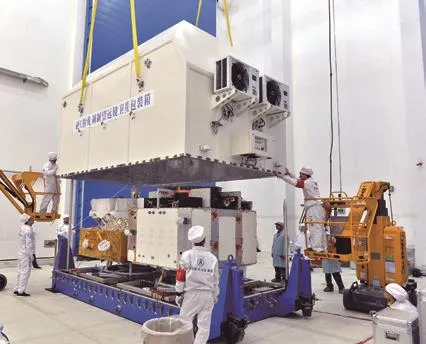China’s First Hard X-Ray Astronomical Satellite Formally Put into Service
2018-02-20RENYueming
A ceremony was held on January 30 to announce the Huiyan satellite,China’s first Hard X-ray Modulation Telescope (HXMT) put into service.HXMT was formally delivered and put into service after it completed test tasks covering the satellite platform, payloads and ground application system.
The Huiyan satellite developed by CASC, was launched with a LM-4B carrier rocket in June 2017 from the Jiuquan Satellite Launch Center. It is a major independent innovative space scientific program that aims to study the frontier sciences such as those of black holes and neutron stars. The application of the satellite signifies China moving into space observation in the high-energy astronomy research area, which is of great significance to improve China’s international status and influence in space science.

HXMT is under preparation for launch
Deputy Director of State Administration of Science, Technology and Industry for National Defence (SASTIND)and China National Space Administration (CNSA) WU Yanhua, Secretary-General of CNSA TIAN Yulong, and Vice President of CASC YANG Baohua attended the ceremony.
At the ceremony a brief introduction to HXMT was given along with details of the preliminary scientific results of in-orbit testing and the conclusions of in-orbit testing. The direct demodulation method of HXMT enables it to fulfill all-sky scans, pointed observation and narrow-field scanning observation with broad band, high sensitivity and high resolution. Among all the existing X-ray astronomical satellites in the world, HXMT has the advantage of advanced dark weak source transformation with all-sky scan ability and unique multi-band fast optical transformation observation ability. During the in-orbit testing, HXMT conducted scan imaging observation of several celestial regions and pointed observation of certain celestial bodies, application tests such as gamma ray burst monitoring and verification of functions and performance of the satellite were completed. HXMT established an upper limit for gamma ray monitoring of its high-energy electromagnetic radiation sensor with the discovery of the event GW170817,gravitational waves created by the merging of two neutron stars, which was announced on October 16, 2017.The test demonstrated that the satellite is in good condition and is ready to be put into routine service.
At the ceremony, CASC and Chinese Academy of Sciences (CAS) signed an operational certificate, while China Academy of Space Technology (CAST),National Space Science Center and Institute of High Energy Physics under CAS and China Xi’an Satellite Control Center signed a long-term operation management protocol.
According to YANG Baohua, HXMT embodies a new phase in China’s hard X-ray astronomy research, helping China, in the field of high-energy astrophysics, realize the development from ground observation to space-ground joint observation. President XI Jinping mentioned that “Good news about scientific innovation and major program construction keeps pouring in, HXMT is traveling in space.” This is government’s affirmation of the satellite which inspires us to unite as one, work hard and try our best to complete the various space missions. CASC will continue to contribute to the development of China’s space industry.
At present, CNSA is actively promoting the implementation of the HXMT data management regulations in order to standardize the data management and promote the growth of data applications and scientific output.
杂志排行
Aerospace China的其它文章
- Study on Measuring Device for Bearing Clearance of Hemisphere Dynamic Pressure Motor
- Study on Multi-Rotary Joints Space Power Satellite Concept
- Exploration of CASC’s Commercial Space
- SuperView-1-China’s First Commercial Remote Sensing Satellite Constellation with a High Resolution of 0.5 m
- Space Development with Chinese Characteristics and its Practical Significance
- China Successfully Launches First Operational Civil Optical Constellation
